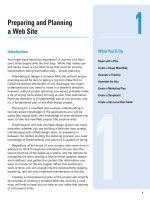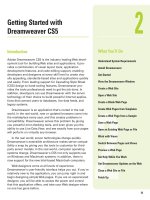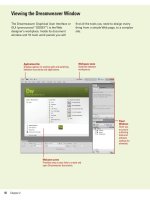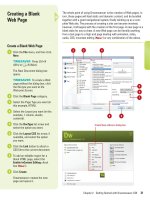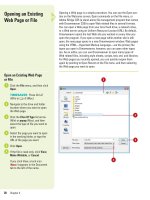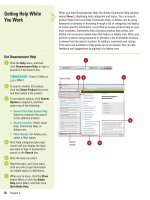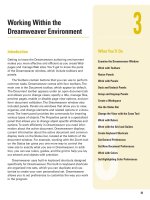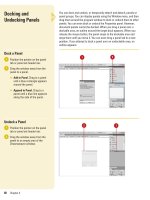adobe dreamweaver cs5 on demand part 82 pptx
Bạn đang xem bản rút gọn của tài liệu. Xem và tải ngay bản đầy đủ của tài liệu tại đây (553.18 KB, 5 trang )
ptg
502 Chapter 21
Adobe Business Catalyst is a hosted Web site solution that allows you to
build dynamic, data-driven Web sites with some advanced features,
such as search, forums, blogs, password protected areas, web forms,
and online stores (New!). Dreamweaver uses the Business Catalyst
extension to connect you directly to your online business site, where
you can add, edit, delete, upload pages and templates in Dreamweaver,
and use pre-build code modules without programming from the
Business Catalyst panel. You can get the extension by using the
Business Catalyst panel and install it by using the Adobe Extension
Manager.
Working with
Business Catalyst
Site Files
Download and Install the
Business Catalyst Extension
Click the Window menu, and then
click Business Catalyst to display
the Business Catalyst panel.
Click the Get the Extension button
to access the Business Catalyst
Web site.
Follow the online instructions to
access and download the
Business Catalyst extension, and
then close your browser.
Click the Help menu, and then
click Manage Extensions.
Click the Install button, navigate to
and select the Business Catalyst
extension, click Open, and then
complete the install.
To enable the extension, select the
Enable check box.
Click the Close button.
7
6
5
4
3
2
1
2
1
56 7
Adobe Business Catalyst extension
From the Library of Wow! eBook
ptg
Chapter 21 Moving Your Site to the Internet 503
Get Started with a Business
Catalyst Site
Click the Window menu, and then
click Business Catalyst to display
the Business Catalyst panel.
◆ If you have not created a
Business Catalyst site, visit
www.businesscatalyst.com
,
click Free Sign Up, and then
follow the online instructions.
◆ The first time you work with
Dreamweaver, you need to
define the local root folder in
the Site Setup dialog box.
Enter your username (e-mail
address) and password, and then
click Login.
Click the Site list arrow, and then
select your site.
◆ To define a site, click the Quick
Site Setup icon in the Business
Catalyst panel, and then follow
the wizard instructions. Select
the Download Site Locally
check box, and then click Done.
This sets up your testing server.
Use the toolbar in the Files panel
to work with files on the remote
and local sites. To open a local file,
double-click it.
◆ Click the Window menu, and
then click Files to display the
Files panel, and then click the
Expand button to show local
and remote sites.
To add a module to an open Web
page, open the Web page you
want, click to place the insertion
point, select the module in the
Business Catalyst panel, double-
click the wizard icon, follow the
step-by-step instructions, and then
click Insert.
5
4
3
2
1
Setting up an online business catalyst site
5
3
Wizard icon
Module wizard
From the Library of Wow! eBook
ptg
504 Chapter 21
In Web development, sometimes it can get confusing managing ver-
sions of files. Where is the most recent file? This question is one that
you'll probably ask yourself more than once throughout the develop-
ment of a site. Dreamweaver solves this problem with an option called
File Synchronization. This feature compares files between the local and
remote site and will determine which is the latest version. If the latest
version lives on the local site, it will upload that file accordingly. File
Synchronization can also delete files on either the local or remote site,
if the file doesn't appear in both versions of the site. You can apply the
synchronize command to selected files, or apply it site-wide.
Synchronizing Site
Files
Synchronize Files
Click the Window menu, and then
click Files to display the Files
panel.
Click the Expand button to show
local and remote sites.
Select the file or files that you
want to synchronize (local or
remote).
Click the Synchronize button.
TIMESAVER
Click the Site
menu, and then click Synchronize
Sitewide.
Select from the following
synchronize options:
◆ Synchronize. Select between
synchronizing the entire site, or
only selected files.
◆ Direction. Select Put Newer
Files To Remote (default), Get
New Files From The Remote, or
Get And Put Newer Files
(wherever they exist).
◆ Delete Remote Files Not On
Local Drive. Select to allow
Dreamweaver to delete any
files found on the remote
server, but not on the local
drive.
5
4
3
2
1
4
3
6
5
2
From the Library of Wow! eBook
ptg
Chapter 21 Moving Your Site to the Internet 505
Click Preview to view the
proposed changes.
Select a file or files, and make
modifications using the following
options:
◆ Mark selected files to get the
remote version.
◆ Mark selected files to put the
local version.
◆ Mark selected files for deletion.
◆ Ignore selected files during this
synchronization.
◆ Mark selected files as already
synchronized.
◆ Compare the local and remote
versions of the selected files.
NOTE
If no synchronization is
required, Dreamweaver prompts
you with a dialog box, asking if you
want to see a list of the files, and
then change them manually.
Click OK.
Once the synchronization is
complete you can save a log of the
actions performed by pressing the
Save Log button.
8
7
6
87
Did You Know?
You can display detailed information
for a synchronized file.
In the Files
panel, right-click (Win) or control-click
(Mac) the file you want information,
and then click Display Synchronize
Information. This command is available
only when the Maintain Synchron-
ation Information check box is selected
in the Remote Info category of the Site
Setup dialog box.
From the Library of Wow! eBook
ptg
506 Chapter 21
Cloaking files hides the selected files from many of the file transfer
commands, such as: Get, Put, Check In, and Check Out; however, it
doesn’t protect files when using Synchronize. For example, you have a
folder on you local site that contains original uncompressed source
documents, such as Photoshop and Flash. There would be no need for
these files to be uploaded to the remote server, so you cloak them. Any
file format you cloak remains in your local folder and will not be
uploaded unless you manually override the cloak setting. In addition,
cloaked files do not appear in the Assets panel. Cloaked files can be
controlled by extension, such as all FLA files, or they can be controlled
individually, regardless of their extension. You can cloak specific fold-
ers, even multiple ones; however, you cannot cloak all folders or an
entire site.
Cloaking and
Uncloaking Files
Cloak and Uncloak Files
Click the Window menu, and then
click Files to display the Files
panel.
Click the Expand button to show
local and remote sites.
Select the files or folder within the
site files, right-click (Win) or
control-click (Mac) the selection,
point to Cloaking, and then click
Cloak or Uncloak.
A red line through the folder icon
appears or disappears, indicating
the folder is cloaked or uncloaked.
3
2
1
2
3
See Also
See “Defining Site Cloaking” on page
484 for information on enabling cloak-
ing and specifying the file types you
want to cloak.
Did You Know?
You can uncloak all files at the same
time.
In the Files panel, select any file
or folder in the local site, right-click
(Win) or control-click (Mac) the selec-
tion, point to Cloaking, and then click
Uncloak All.
From the Library of Wow! eBook
